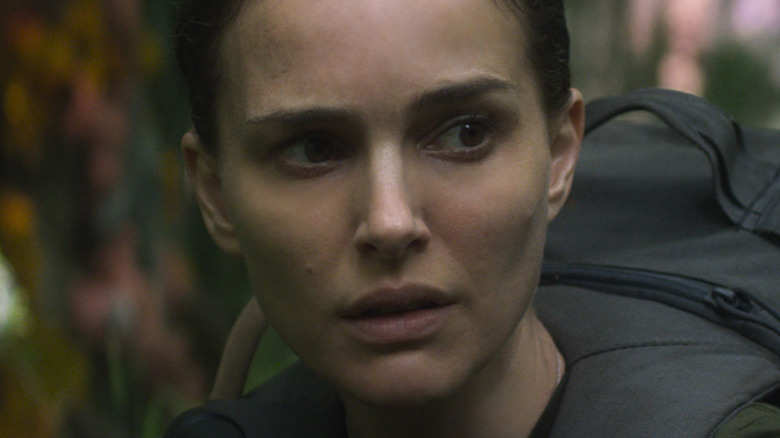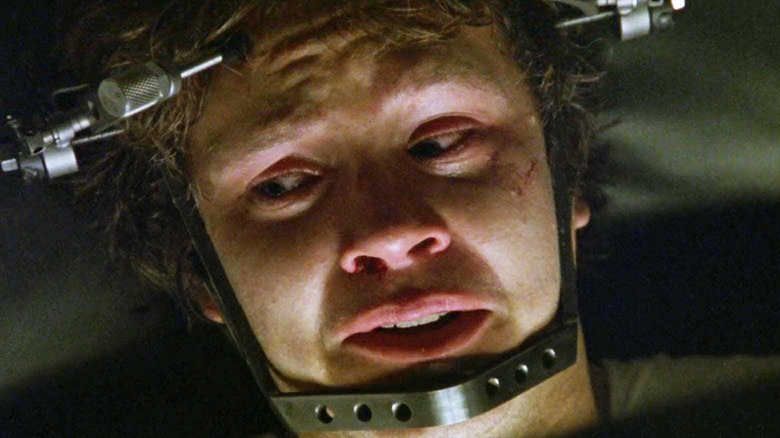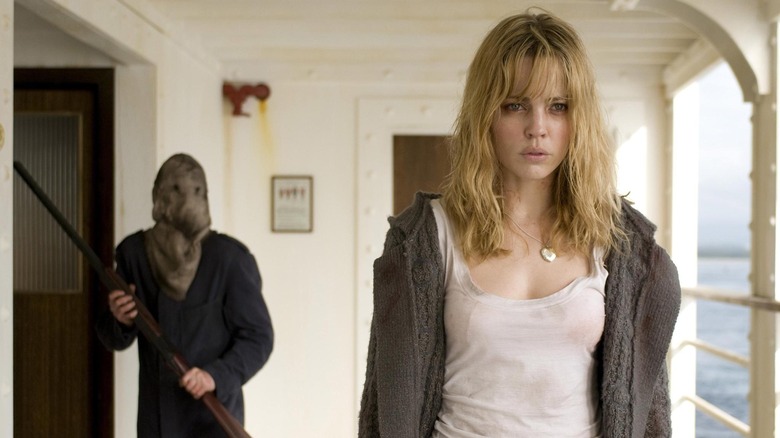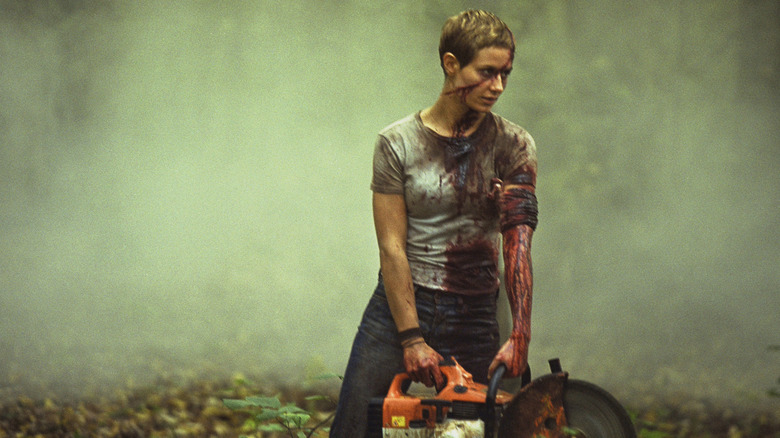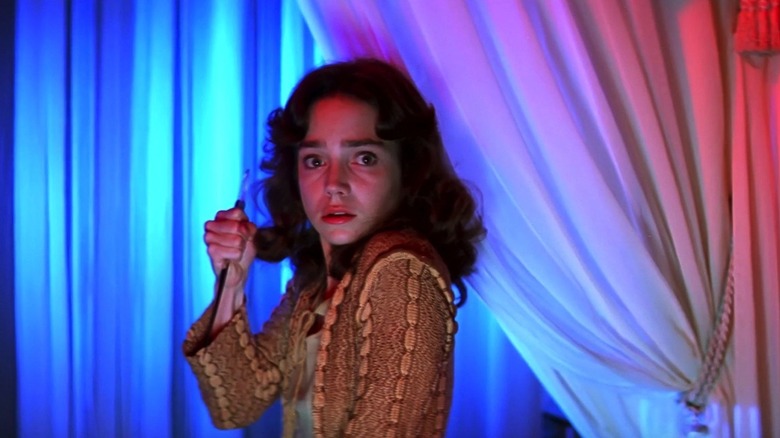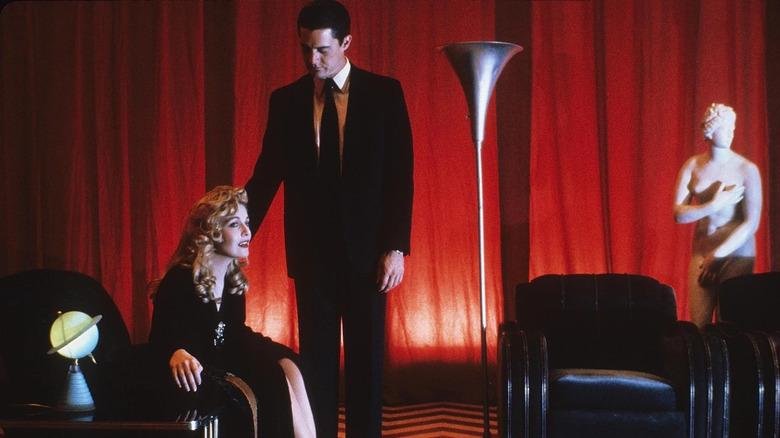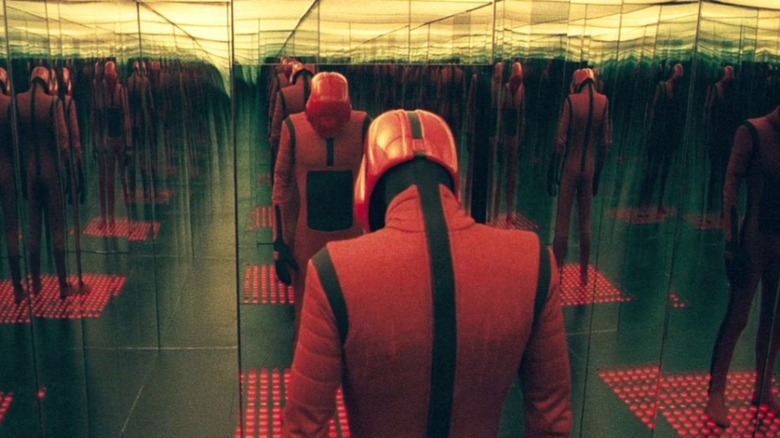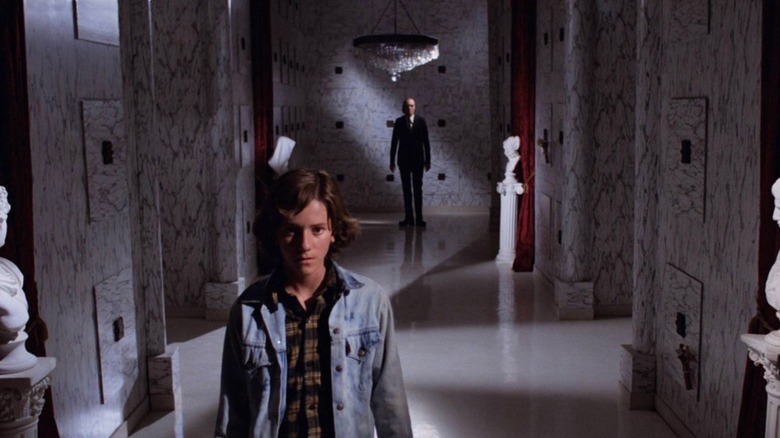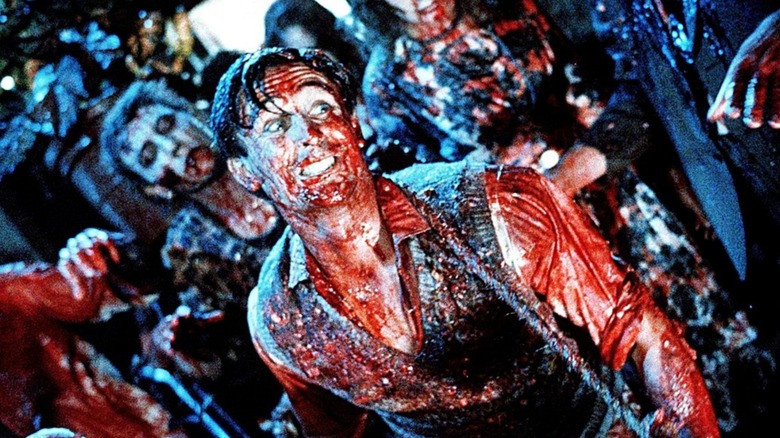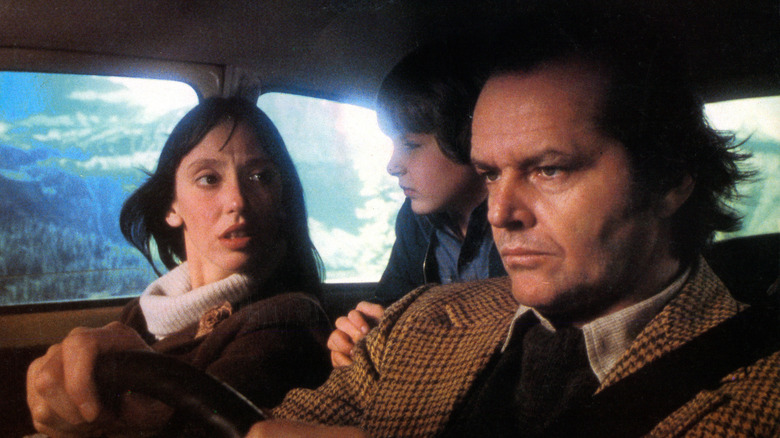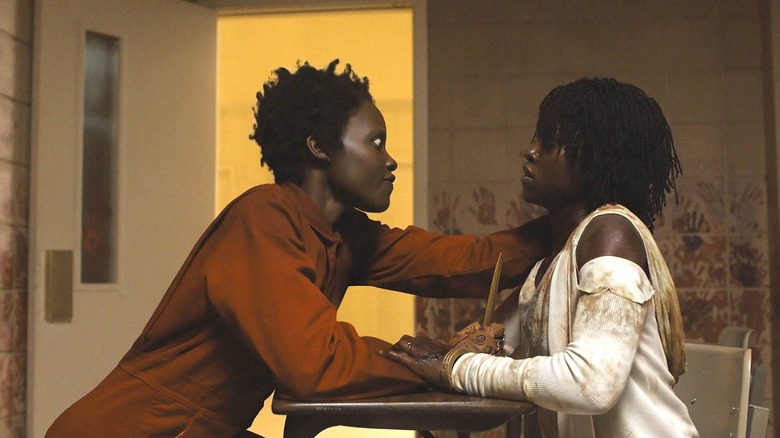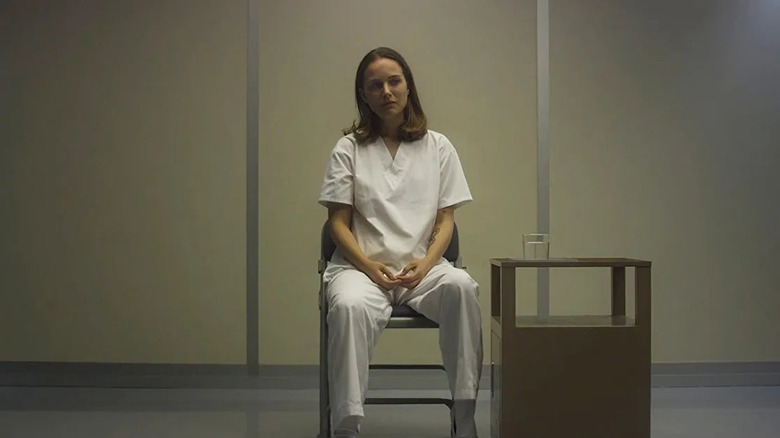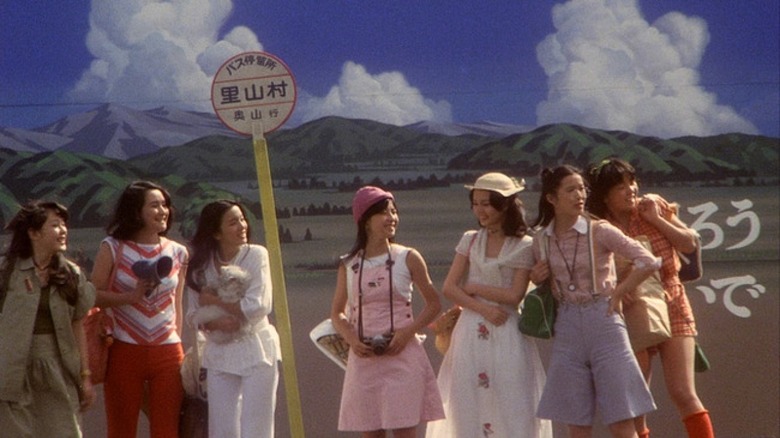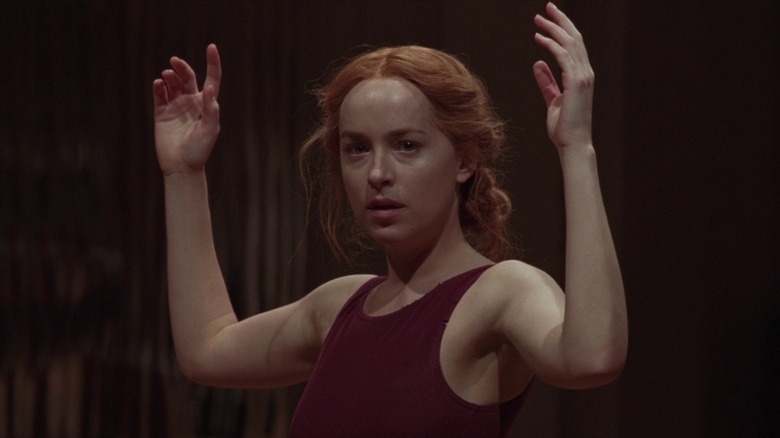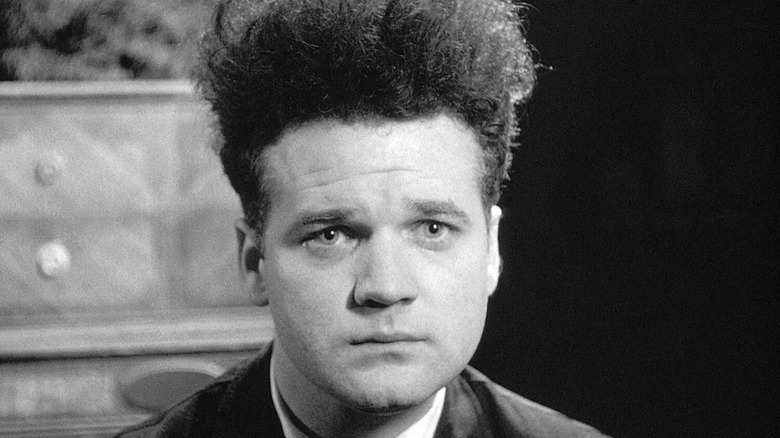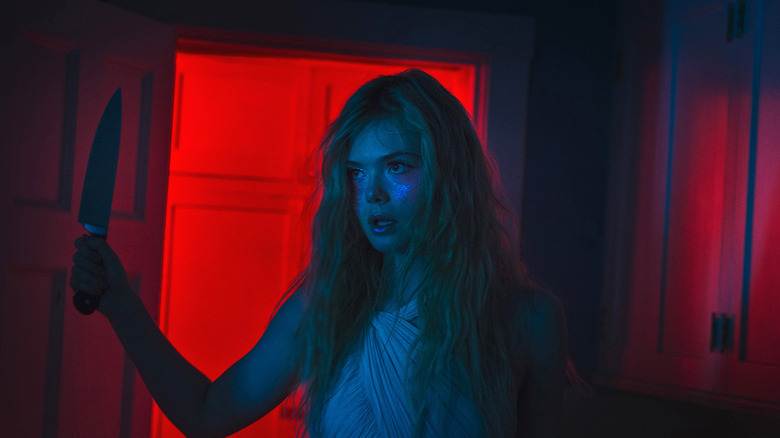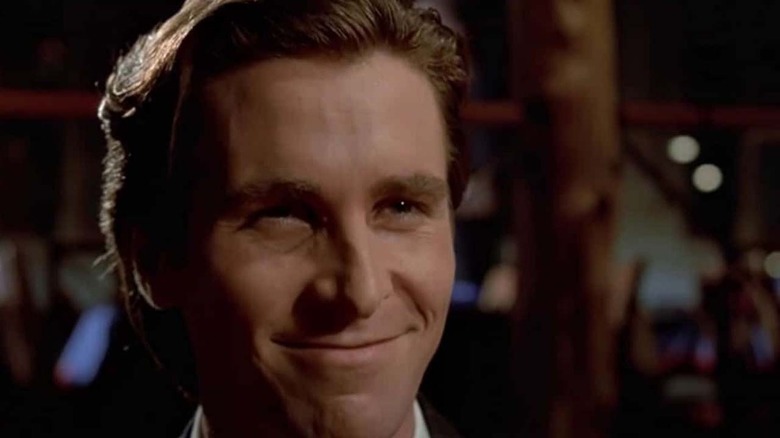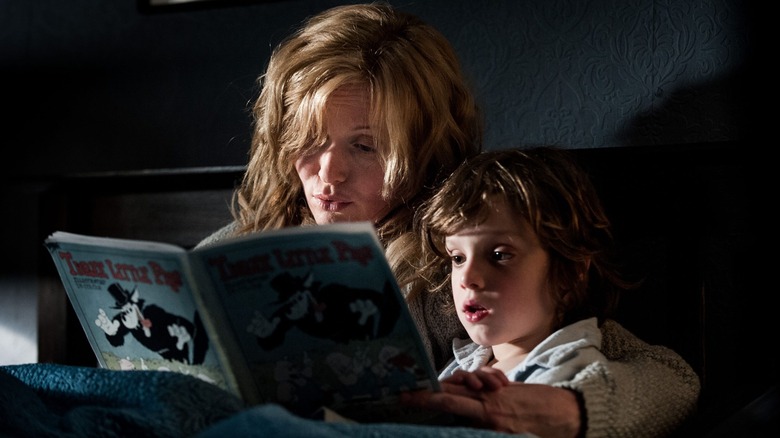Horror Movies People Still Don't Understand
When done right, horror movies can appeal to our basest id — giving audiences a platform to safely face their fears in the confines of a controlled environment. In many cases, a compelling story is only half of what makes a horror film entertaining, though. If you ask us, the best horror films are usually the ones that keep audiences talking — picking apart that odd story twist, bloody kill sequence, or jaw-dropping third act.
For every straightforward slasher or found-footage ghost story, there are unusual pickings perfect for a midnight viewing at that indie arthouse theater you love so much. These are the films that broke your brain, raised your eyebrow, and those that took the more esoteric route in their execution. From the subversive to the straight-up bonkers, here are some horror movies that many audiences still haven't completely wrapped their heads around.
Jacob's Ladder (1990)
A key detail that ties everything together in "Jacob's Ladder" is the Vietnam War. You see, Jacob Singer (Tim Robbins) is a war vet who is seriously injured on the battlefield at the beginning of the movie. Throughout the duration of the film, we're given a glimpse into Jacob's past as a married father of three. However, the timeline bounces around a bit, from his joyful past life to the dreary reality of his present. Add in some faceless demonic killers and you've got yourself one heck of a story.
Through the surreal imagery and psychological tension of it all, the story presents a resolution in its third act: Jacob's actually been dead this entire time. War is hell, you guys, and the chemical warfare the film alludes to finds the blurring realities of a soldier on the battlefield. Jacob was killed by someone in his own squad.
What begins as a psychological thriller steeped heavily in demonic symbolism quickly turns a corner into an allegory of heaven, hell, and the place troubled souls can get stuck in between. Shout out to Danny Aiello's angelic chiropractor! If we're ever unlucky enough to find ourselves in purgatory, you best believe we'll do our best to track him down.
Triangle (2009)
Christopher Smith's "Triangle" is an odd movie, for sure. The story here sort of feels like it would work better as an episode of "Black Mirror."
Smith's 2009 film centers on Jess (Melissa George), a troubled mother who goes on a yacht trip with a group of friends. From the very beginning of the story, she's under the impression that something is wrong. After a storm hits the boat, her crew finds rescue in a passing ocean liner — and yet, that foreboding feeling only gets worse for Jess. And for good reason: There's a killer on the boat!
That reveal is the first in a long line of twists that throws Jess face-to-face with — wait for it — herself. While the film relies heavily on the trope of a horror film time loop, it's an intriguing thing to watch Jess attempt to murder every version of herself and her friends she comes across, all with the goal of breaking the cycle. Yet no matter how hard she tries, she never breaks free.
The ending of "Triangle" may not provide audiences the clear-cut closure they expected, but it's definitely one of those films that get you thinking about the hidden impact of habitual behaviors and the everyday minutiae we all endure.
High Tension (2003)
The story of Alexandre Aja's "High Tension" is simple enough: College friends Marie (Cécile De France) and Alex (Maïwenn) head to a secluded farmhouse to study without any annoying distractions. That plan doesn't work out, though, as a man breaks into the farmhouse and begins murdering every member of Alex's family. Brutal in its depiction of these murders, "High Tension" builds upon the bond between Marie and Alex while piecing together the killer's identity and motives.
Unfortunately, the whole thing falls apart in the third act, revealing that the mysterious killer is actually Alex herself. Tortured by the trauma of her childhood, it seems she's manifested multiple personalities, one being this madman out to destroy her and her friends. While it's an intriguing detail, this reveal sort of undermines the first two acts because the plausibility of certain horror story components simply doesn't hold up when faced with basic logic.
If you or someone you know needs help with mental health, please contact the Crisis Text Line by texting HOME to 741741, call the National Alliance on Mental Illness helpline at 1-800-950-NAMI (6264), or visit the National Institute of Mental Health website.
Suspiria (1977)
Easily considered a horror classic, Dario Argento's "Suspiria" takes on the occult in a manner that has inspired countless copycats since the film's 1977 release. The film is a prime example of style over substance — and that's not a bad thing.
Told in Argento's signature Grand Guignol style — which relies more on the ultra-violent production value and brooding tone than one clear-cut cohesive story — "Suspiria" explores the story of a dancer, Suzy Bannion, who travels to Germany's Tanz Dance Academy to perfect her ballet abilities.
The audience is quickly drawn into Suzy's experience in this surreal new world as strange things begin happening around her. She gets sick, the school suffers a maggot infestation, the pianist dies at the hands (paws?) of his own dog, and, needless to say, it comes as no shock when Suzy discovers that this illustrious dance school once was — and still is — a witches' coven.
Twin Peaks: Fire Walk with Me (1992)
When ABC canceled "Twin Peaks" in 1991, David Lynch took it upon himself to continue the story of Laura Palmer's (Sheryl Lee) murder by taking a trip back in time. "Twin Peaks: Fire Walk with Me" tells the story of Laura's life during the week leading up to her untimely death, and in the process, takes audiences deeper into Lynch's bizarre story world.
Showtime's 2017 "Twin Peaks" revival series regularly revisited plot points introduced in the movie prequel: the Black Lodge, that delicious Garmonbozia, the Arm, two Agent Coopers, and David Bowie's Philip Jeffries are out in full force here. If ever there was a horror movie that defies conventional explanation, this would most definitely be it.
Beyond the Black Rainbow (2010)
When it comes to style over substance, "Beyond the Black Rainbow" is chock full of visuals to keep audiences looking to zone out on pretty lights and whatnot. But when it comes to story, that's where Panos Cosmatos' 2010 film quickly falls apart. The film follows Elena (Eva Allan), a mute girl with psychic powers, who is being kept prisoner in an institution by a crazed doctor who obviously gets off on watching her beg and weep on his many security monitors. But she's also dangerous and shows she can pull off some "Stranger Things"-style murder with her mind.
Overall, the story of the film boils down to the conflict between doctor and patient, using this surreal futuristic-looking hospital as its backdrop. As surreal as the Kubrick-y imagery is, though, nailing down an actual plot becomes quite difficult when pressed, leaving us fully convinced that Cosmatos' stylistic slow burn was meant to appeal to audiences on a more subconscious level. When viewing "Beyond the Black Rainbow" with those expectations in mind, one may finish viewing the movie in an altered mindset. But if you're out to find a clear-cut first, second, and third act, you've got another thing coming.
Phantasm (1979)
At 23, director Don Coscarelli really kicked off his filmmaking career with a head-scratcher that's equally imaginative and horrific.
"Phantasm" follows a boy named Mike (Michael Baldwin) who witnesses some odd, Jawa-looking minions stealing bodies from the local cemetery. This leads Mike and brother Jody (Bill Thornbury) on an investigative mission to check out the mausoleum, where they happen upon an evil mortician — better known as the Tall Man (Angus Scrimm) — who has apparently found a portal to another dimension and uses dead flesh to keep this netherworld happy.
This discovery sends the Tall Man on a mission to capture Mike and Jody, birthing his iconic horror movie phrase, "Boy!" Oh, let's not forget that murderous silver ball that flies into people's skulls with the sole purpose of retrieving brain meat...
For the late '70s, "Phantasm" was definitely a horror film that left audiences wanting more. But the third act falls apart a bit, leaving audiences wanting to know exactly why the Tall Man is doing what he's doing. Thankfully, Coscarelli returned to the world and characters he created nine years later with 1988's "Phantasm II," kicking off a quirky (and gory) little franchise beloved by many diehard horror fans.
Dead Alive (1992)
Long before Peter Jackson made a name for himself with the "Lord of the Rings" movies, he brought 1992's bonkers horror goodie "Dead Alive" (originally titled "Braindead") to the world. What you've got in "Dead Alive" is a simple New Zealand love story buried deep inside a zany undead apocalypse.
The film follows hapless hero Lionel Cosgrove (Timothy Balme), who struggles to keep his cookie-cutter suburban family together as a rat bite turns normal folks into crazed flesh-eating zombies. But because they're family, Lionel does his best to keep them hidden in his basement. As you can imagine, things don't go according to plan and it's not long before he takes on things into his own hands — shedding tons of zombie blood along the way — to save Paquita (Diana Peñalver), his one true love.
You can easily bypass any confusion by looking at "Dead Alive" as a story of love and redemption. But there's a whole lot of family drama included in Jackson's tale that gives the story some weird, uncomfortable layers. The gory combination of humor and horror puts this movie in a category all its own.
The Shining (1980)
Stephen King may have gone on record many times regarding his disdain for Stanley Kubrick's 1980 adaptation of his classic story "The Shining" — and it does deviate a lot from the source material — but the Jack Nicholson and Shelley Duvall-starring film is a classic for a reason. Intense performances, disturbing imagery, epic camera work, and twists galore put this movie in a class all its own—and have fed into so many conspiracy theories that it'll make your head spin.
On the surface, King's tale explores the story of a fractured family on a descent into madness. Jack Torrance (Nicholson) and his son Danny (Danny Lloyd) share telepathic abilities — Danny's aware of it, but Jack is not — which brings things to a chaotic and bloody crescendo as the family takes root in the haunted Overlook Hotel. As a horrific ghost story, "The Shining" works wonders. But if you go deeper into the theories, many of which are outlined in the documentary "Room 237," you'll start seeing odd narrative layers you may not have recognized before ... and plenty of lingering questions that still leave many fans perplexed.
mother! (2017)
Darren Aronofsky isn't the type of director who goes the commercial route, and 2017's "mother!" is a prime example. What exactly is this movie about!?
Jennifer Lawrence and Javier Bardem star as a married couple looking to rebuild their lives after a tragic fire that left Bardem's life in ruins. But as we watch Lawrence resurrect the home from the ground up, odd events begin to happen that seem to link her own health with that of the house. After an odd encounter with a couple of strangers, Bardem's poet impregnates Lawrence's muse and as the couple prepares for the birth of their boy, a work of art is born from Bardem's psyche.
This is where things go full-on batty in the movie, bringing looters, cult members, riot police, and all-out war into the house that mother built. In the end, audiences are left with a visual onslaught that's anxiety-inducing, upsetting, and downright confusing.
Was Jennifer Lawrence's character the symbol of mother nature? Is Bardem's poet really a look at the power of humanity in relation to Earth's slow destruction? Or could this simply be Aronofsky's visceral take on the artist's struggle to find inspiration and the many muses that die under the guise of creativity and art? There's a lot to unpack here for sure. But in a world of formulaic pop culture, "mother!" keeps the conversation going. And sometimes, a little thought-provoking is all one needs to make a movie feel worthwhile.
Us
After the success of Jordan Peele's "Get Out," horror fans knew to expect layers of metaphor and social commentary from the director's next venture. What they didn't expect was that "Us," Peele's second feature, would be even denser in its construction than "Get Out." While it conceivably starts off as a home invasion movie about a Black family being invaded by a family of doppelgangers known as the Tethered, "Us" slowly unravels its layers of meaning.
As Adelaide chases down her doppelganger Red (with both characters played by Lupito Nyong'o), she winds up at the beach boardwalk where the movie begins. In the house of mirrors, she discovers she is where the Tethered come over to the human world and goes into Red's world where we learn the movie's big twist. The Tethered is a failed experiment the government was using to try and control people above ground with their counterparts underneath. As if that's not enough, the movie throws one final cryptic flashback sequence at you before the cut to the credits.
The implication of the final sequence in "Us" might have gone over some people's heads, especially on the first viewing. While she is driving to safety, Adelaide thinks back on her childhood encounter with Red. At this moment she remembers that the two of them switched that day. The Adelaide we know is the Tethered who was born underground, trapping her counterpart below and replacing her in life above ground.
Annihilation
Alex Garland's film "Annihilation," based on the novel by Jeff VanderMeer, might have one of the most confusing movie endings of all time. Biologist Lena (Natalie Portman) decides to take a journey into the unknown after her husband Kane (Oscar Isaac) returns from a three-year disappearance. Along with a team of other female experts, Lena thrusts herself into a mysterious meteor fallout zone known only as "the Shimmer" to try and find out what happened to Kane during his time there. If you are looking for a straightforward answer to this setup, "Annihilation" will not deliver.
Instead, "Annihilation" skirts the fine line between horror and sci-fi as Lena and her crew go further into the Shimmer. They discover that the Shimmer causes light refractions that mix DNA, explaining the mutant plants and animals in the zone. But at the very end, only Lena remains as she arrives at a lighthouse only to encounter a fractal that absorbs her blood and creates a translucent humanoid that mimics her. The sequence stretches on for minutes before Lena destroys the doppelganger and returns to have one final cryptic exchange with her husband. But what does all this mean?
Working backward, it becomes clear that Lena is aware her new Kane is a doppelganger that has fully transformed. She sees that he is not who he was before while recognizing at the same time she has changed after being in the Shimmer. There are many ways to interpret this ending as being about death or disease, but Garland told Google that "Annihilation" is a movie about "self-destruction."
House (1977)
"House" (or "Hausu") is the definition of a cult classic. This Japanese horror movie from 1977 operates almost entirely in dream logic. The results are some of the most entertaining and confounding 88 minutes ever put onto film.
In "House," a pretty young girl known only as Gorgeous takes six friends to her aunt's rural home for summer vacation. Once they arrive, the house reveals itself to be a wacky haunted mansion that starts eating the girls alive. One girl is even eaten by the piano, starting with just her fingers. And that is far from the strangest thing that happens in "House." Eventually, you learn Gorgeous' aunt died decades ago waiting for her fiancé to return from World War II, and ever since, the house has been luring in and killing unmarried girls.
While it is best to enjoy "House" for the visual splendor and absurdity, there is some real depth to its content as well. Director Nobuhiko Obayashi would go on to make very explicit anti-war movies like "Hanagatami" in his late career. These themes of the ways war haunt both people and a nation are present in a nascent form in the subtext of this 1977 surrealist nightmare.
Suspiria (2018)
Luca Guadagnino's "Suspiria" is a completely different movie than the 1977 original, both tonally and thematically. While the basic plot remains the same — Guadagnino's Susie (Dakota Johnson) attends a dance school in West Berlin in 1977 — and takes aspects from Dario Argento's entire Three Mothers trilogy, Guadagnino weaves a story that has historical meaning on top of the already confusing story of the surrealist original.
While Susie still ultimately discovers the true identity of Mother Markos (Tilda Swinton) and the witch coven, there is a seemingly irrelevant new side plot about Dr. Josef Klemperer (also played by Swinton). This might seem to distract from the horror and tension of the 2018 "Suspiria," but the addition of this character ties the surreal story to real history. Klemperer's conflict revolves around losing his wife in World War II. The guilt and grief he feels are a metaphor for living in that time period in Germany.
At the end of "Suspiria," Susie (now transformed into Mother Suspirium) visits him on his deathbed, and she grants Klemperer what he has been searching for: the truth. She reveals to him that his wife died after being captured in the war before giving him the final push over the edge to be with his love forever. It is a touching, tragic love story at the heart of this historical (and horrific) epic.
Eraserhead
Every David Lynch movie is confusing, and, to some extent, every David Lynch movie is a horror movie. So picking one to represent his entire filmography was a nearly impossible choice. While "Mulholland Drive" or "Lost Highway" could slot in here, it is Lynch's debut that still mystifies and puzzles viewers after over 45 years. "Eraserhead" is a surrealist black-and-white film that investigates the horrors of domestic life in the most extreme ways possible.
Henry Spencer (Jack Nance) lives in a suburban industrial wasteland with his mother. One day, he is informed that his girlfriend has had a child, but what they have created is anything but human. When she hysterically leaves him to take care of the child for what feels like an endless amount of time, Spencer brings us into his hallucinatory world filled with metaphorical visions and characters. "Eraserhead" ends with Spencer killing the creature to put it out of its misery. Taking these events logically is the wrong way to look at this deeply metaphorical film.
The main theme the ending of "Eraserhead" reinforces is the anxiety of parenthood. The film also touches on infidelity and Oedipal relationships between men and mother figures. All these adult themes are explored through David Lynch's inexplicable way of viewing the world. Some of the weirder parts of the film will never be explained, and that's just what the director wants.
The Neon Demon
After the break-out success of "Drive," Danish filmmaker Nicholas Winding Refn was poised to make some of the next decade's classics. Instead, Refn followed up the stylish "Thief" homage with two completely baffling films, the second of which was the Elle Fanning-led fashion horror flick "The Neon Demon." In it, Fanning plays Jesse, a young fashion model who has recently moved to Los Angeles. There she meets a group of models and their makeup artist Ruby (Jena Malone) who immediately take an interest in her.
As Jesse befriends the women she begins to see more of their narcissistic personalities and sexual deviancy. "The Neon Demon" is graphic, but it is fairly straightforward in Jesse's transformation from innocence to Hollywood narcissism. That is until the ending where she is killed and eaten by her friends. In the final scene, Gigi (Bella Heathcote) then beings regurgitating parts of her before killing herself while saying "I need to get her out of me."
On the surface, the twist in "The Neon Demon" serves as a metaphor for Hollywood and being a model or actress. The system will change your values and then eat you alive. This is made literal in the film. However, there is also a deeper layer here. Gigi's body rejects Jesse's organs, which symbolizes how she became rotten or impure. In the process of entrapping and capturing their prey, they have ruined what made Jesse desirable in the first place.
If you or anyone you know is having suicidal thoughts, please call the National Suicide Prevention Lifeline by dialing 988 or by calling 1-800-273-TALK (8255).
American Psycho
Christian Bale is unforgettable as Patrick Bateman, the much-memed psychopathic yuppie at the heart of Mary Harron's divisive adaptation of the Brett Easton Ellis novel. Bateman lives a privileged life in 1980s Manhattan, privileged enough that it seems that he routinely gets away with the murder of sex workers and colleagues. By the end of "American Psycho," Bateman is a full-blown serial killer driven to madness by the lack of consequences for his actions. And then the movie just ends. So what gives?
After a chaotic killing spree and a phone call confessing his crimes to his lawyer, Bateman finds himself at a lunch with his colleagues and everything is entirely normal. In his final monologue, Bale says "There is an idea of a Patrick Bateman; some kind of abstraction. But there is no real me: only an entity, something illusory." This confusing ending of "American Psycho" left audiences stumped, but it all boils down to one factor — the unreliable narrator.
Read closely and you'll notice this ending cements the movie's satire. On one hand, there is the interpretation that Bateman is powerful enough that he can get away with whatever he pleases and his associates will cover for him. As horrifying as that might be, the darker ending is that Bateman can no longer tell the difference between his psychotic fantasies and realities. Ultimately, it is left ambiguous as to how many of the killings in "American Psycho" actually happened and how much was in Bateman's head.
The Babadook
In Jennifer Kent's "The Babadook," the real monster is never on screen. Six years after the tragic death of her husband, Amelia (Essie Davis) struggles to raise their son Sam (Noah Wiseman) as he becomes obsessed with a pop-up book character. After reading "Mister Babadook" to Sam, the two experience shared hallucinations in which the Babadook has come to life.
In the end, Amelia and Sam finally confront the Babadook that is haunting them not by killing it, but by recognizing that it won't ever go away and giving it a home in the basement. It's a strange ending if you don't understand the subtext of the film but a perfect one if you do.
The main metaphor at the heart of "The Babadook" is about the shared grief between a mother and her child. The monster represents grief after a traumatic loss. Smartly, the film recognizes that this is the kind of extreme trauma that stays with you forever, but it also comes to the conclusion that there are ways to live alongside it without letting it consume your life. The ending of "The Babadook" shows that Sam and Amelia keep the Babadook locked up in their basement, which is a metaphor for living with grief and mental illness.
